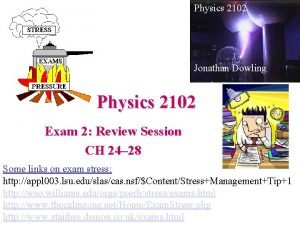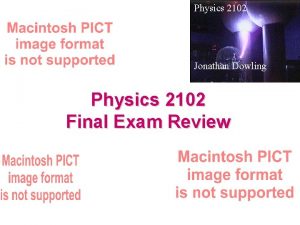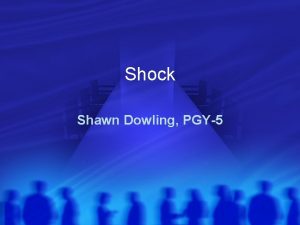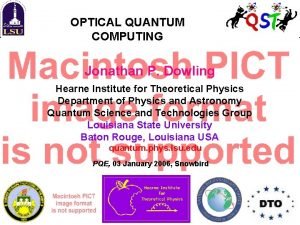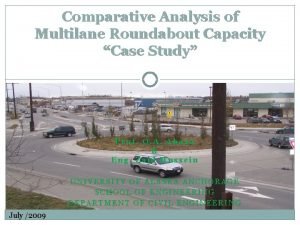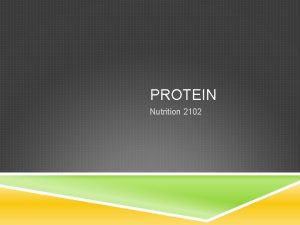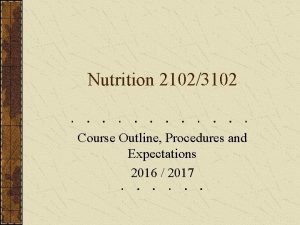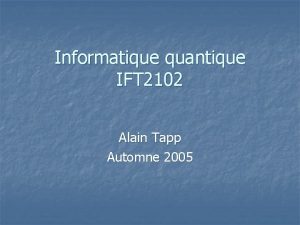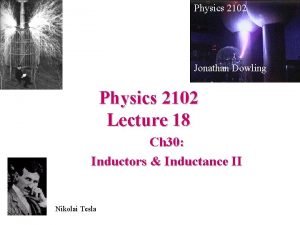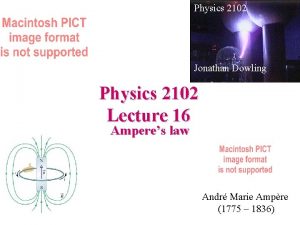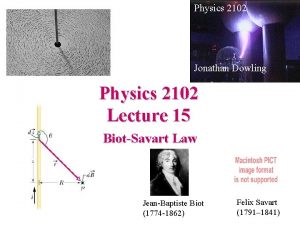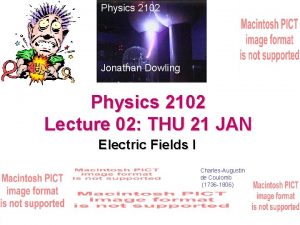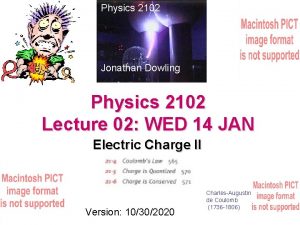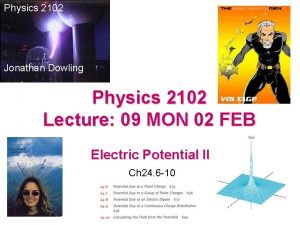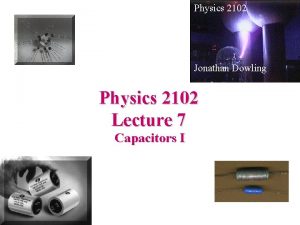Physics 2102 Jonathan Dowling Physics 2102 Lecture 8












- Slides: 12

Physics 2102 Jonathan Dowling Physics 2102 Lecture 8 Capacitors II

Capacitors in parallel and in series • In parallel : – Ceq = C 1 + C 2 – Veq=V 1=V 2 – Qeq=Q 1+Q 2 • In series : – 1/Ceq = 1/C 1 + 1/C 2 – Veq=V 1 +V 2 – Qeq=Q 1=Q 2 Q 1 C 1 Q 2 C 2 Qeq Q 1 Q 2 C 1 C 2 Ceq

Example 1 What is the charge on each capacitor? • Q = CV; V = 120 V • Q 1 = (10 m. F)(120 V) = 1200 m. C • Q 2 = (20 m. F)(120 V) = 2400 m. C • Q 3 = (30 m. F)(120 V) = 3600 m. C Note that: • Total charge (7200 m. C) is shared between the 3 capacitors in the ratio C 1: C 2: C 3 — i. e. 1: 2: 3 10 m. F 20 m. F 30 m. F 120 V

Example 2 What is the potential difference across each capacitor? • Q = CV; Q is same for all capacitors 10 m. F • Combined C is given by: 20 m. F 120 V 30 m. F • Ceq = 5. 46 m. F • Q = CV = (5. 46 m. F)(120 V) = 655 m. C • V 1= Q/C 1 = (655 m. C)/(10 m. F) = 65. 5 V Note: 120 V is shared in the • V 2= Q/C 2 = (655 m. C)/(20 m. F) = 32. 75 V ratio of INVERSE capacitances • V 3= Q/C 3 = (655 m. C)/(30 m. F) = 21. 8 V i. e. 1: (1/2): (1/3) (largest C gets smallest V)

Example 3 10 m. F In the circuit shown, what is the charge on the 10 F capacitor? 5 m. F • The two 5 F capacitors are in parallel • Replace by 10 F • Then, we have two 10 F capacitors in series • So, there is 5 V across the 10 F capacitor of interest • Hence, Q = (10 F )(5 V) = 50 C 5 m. F 10 V 10 m. F 10 V

Energy Stored in a Capacitor • Start out with uncharged capacitor • Transfer small amount of charge dq from one plate to the other until charge on each plate has magnitude Q • How much work was needed? dq

Energy Stored in Electric Field • Energy stored in capacitor: U = Q 2/(2 C) = CV 2/2 • View the energy as stored in ELECTRIC FIELD • For example, parallel plate capacitor: Energy DENSITY = energy/volume = u = volume = Ad General expression for any region with vacuum (or air)

Example • 10 F capacitor is initially charged to 120 V. 20 F capacitor is initially uncharged. • Switch is closed, equilibrium is reached. • How much energy is dissipated in the process? Initial charge on 10 m. F = (10 m. F)(120 V)= 1200 m. C 10 F (C 1) 20 F (C 2) After switch is closed, let charges = Q 1 and Q 2. Charge is conserved: Q 1 + Q 2 = 1200 m. C • Q 1 = 400 m. C Also, Vfinal is same: • Q 2 = 800 m. C • Vfinal= Q 1/C 1 = 40 V Initial energy stored = (1/2)C 1 Vinitial 2 = (0. 5)(10 m. F)(120)2 = 72 m. J Final energy stored = (1/2)(C 1 + C 2)Vfinal 2 = (0. 5)(30 m. F)(40)2 = 24 m. J Energy lost (dissipated) = 48 m. J

Dielectric Constant DIELECTRIC +Q -–Q C = A/d • If the space between capacitor plates is filled by a dielectric, the capacitance INCREASES by a factor • This is a useful, working definition for dielectric constant. • Typical values of are 10– 200

Example • Capacitor has charge Q, voltage V • Battery remains connected while dielectric slab is inserted. • Do the following increase, decrease or stay the same: – Potential difference? – Capacitance? – Charge? – Electric field? dielectric slab

Example • Initial values: capacitance = C; charge = Q; potential difference = V; electric field = E; • Battery remains connected • V is FIXED; Vnew = V (same) • Cnew = k. C (increases) • Qnew = (k. C)V = k. Q (increases). • Since Vnew = V, Enew = E (same) Energy stored? dielectric slab u= 0 E 2/2 => u= 0 E 2/2 = E 2/2

Summary • Any two charged conductors form a capacitor. • Capacitance : C= Q/V • Simple Capacitors: Parallel plates: C = 0 A/d Spherical : C = 4 p 0 ab/(b-a) Cylindrical: C = 2 p 0 L/ln(b/a) • Capacitors in series: same charge, not necessarily equal potential; equivalent capacitance 1/Ceq=1/C 1+1/C 2+… • Capacitors in parallel: same potential; not necessarily same charge; equivalent capacitance Ceq=C 1+C 2+… • Energy in a capacitor: U=Q 2/2 C=CV 2/2; energy density u= 0 E 2/2 • Capacitor with a dielectric: capacitance increases C’= C
